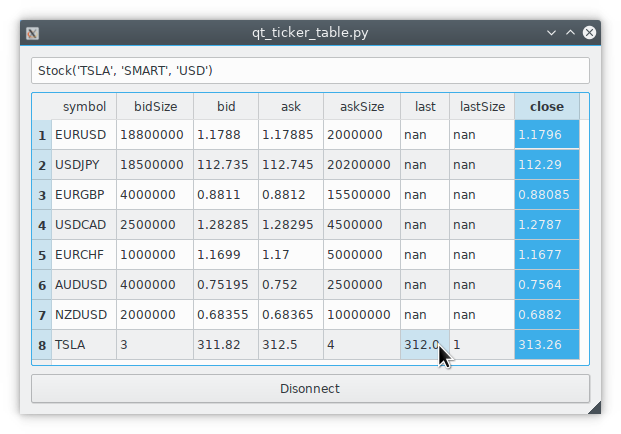Code recipes¶
Collection of useful patterns, snippets and recipes.
Fetching consecutive historical data¶
Suppose we want to get the 1 min bar data of Tesla since the very beginning up until now. The best way is to start with now and keep requesting further and further back in time until there is no more data returned.
import datetime
from ib_insync import *
ib = IB()
ib.connect('127.0.0.1', 7497, clientId=1)
contract = Stock('TSLA', 'SMART', 'USD')
dt = ''
barsList = []
while True:
bars = ib.reqHistoricalData(
contract,
endDateTime=dt,
durationStr='10 D',
barSizeSetting='1 min',
whatToShow='MIDPOINT',
useRTH=True,
formatDate=1)
if not bars:
break
barsList.append(bars)
dt = bars[0].date
print(dt)
# save to CSV file
allBars = [b for bars in reversed(barsList) for b in bars]
df = util.df(allBars)
df.to_csv(contract.symbol + '.csv')
Scanner data (blocking)¶
allParams = ib.reqScannerParameters())
print(allParams)
sub = ScannerSubscription(
instrument='FUT.US',
locationCode='FUT.GLOBEX',
scanCode='TOP_PERC_GAIN')
scanData = ib.reqScannerData(sub)
print(scanData)
Scanner data (streaming)¶
def onScanData(scanData):
print(scanData[0])
print(len(scanData))
sub = ScannerSubscription(
instrument='FUT.US',
locationCode='FUT.GLOBEX',
scanCode='TOP_PERC_GAIN')
scanData = ib.reqScannerSubscription(sub)
scanData.updateEvent += onScanData
ib.sleep(60)
ib.cancelScannerSubscription(scanData)
Option calculations¶
option = Option('EOE', '20171215', 490, 'P', 'FTA', multiplier=100)
calc = ib.calculateImpliedVolatility(
option, optionPrice=6.1, underPrice=525))
print(calc)
calc = ib.calculateOptionPrice(
option, volatility=0.14, underPrice=525))
print(calc)
Order book¶
eurusd = Forex('EURUSD')
ticker = ib.reqMktDepth(eurusd)
while ib.sleep(5):
print(
[d.price for d in ticker.domBids],
[d.price for d in ticker.domAsks])
Minimum price increments¶
usdjpy = Forex('USDJPY')
cd = ib.reqContractDetails(usdjpy)[0]
print(cd.marketRuleIds)
rules = [
ib.reqMarketRule(ruleId)
for ruleId in cd.marketRuleIds.split(',')]
print(rules)
News articles¶
newsProviders = ib.reqNewsProviders()
print(newsProviders)
codes = '+'.join(np.code for np in newsProviders)
amd = Stock('AMD', 'SMART', 'USD')
ib.qualifyContracts(amd)
headlines = ib.reqHistoricalNews(amd.conId, codes, '', '', 10)
latest = headlines[0]
print(latest)
article = ib.reqNewsArticle(latest.providerCode, latest.articleId)
print(article)
News bulletins¶
ib.reqNewsBulletins(True)
ib.sleep(5)
print(ib.newsBulletins())
Dividends¶
contract = Stock('INTC', 'SMART', 'USD')
ticker = ib.reqMktData(contract, '456')
ib.sleep(2)
print(ticker.dividends)
Output:
Dividends(past12Months=1.2, next12Months=1.2, nextDate=datetime.date(2019, 2, 6), nextAmount=0.3)
Fundemental ratios¶
contract = Stock('IBM', 'SMART', 'USD')
ticker = ib.reqMktData(contract, '258')
ib.sleep(2)
print(ticker.fundamentalRatios)
Integration with PyQt5 or PySide2¶

This example
of a ticker table shows how to integrate both
realtime streaming and synchronous API requests in a single-threaded
Qt application.
The API requests in this example are connect and
ib.qualifyContracts(); The latter is used
to get the conId of a contract and use that as a unique key.
The Qt interface will not freeze when a request is ongoing and it is even possible to have multiple outstanding requests at the same time.
This example depends on PyQt5:
pip3 install -U PyQt5.
It’s also possible to use PySide2 instead; To do so uncomment the PySide2
import and util.useQt lines in the example and comment out their PyQt5
counterparts.
Integration with Tkinter¶
To integrate with the Tkinter event loop, take a look at this example app.